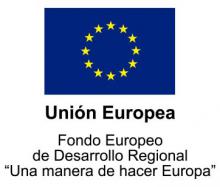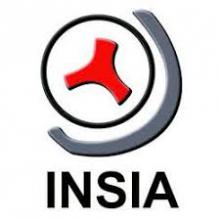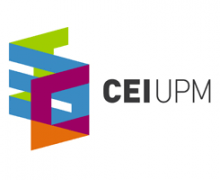OPREVU

The project OPREVU, with reference RTI2018-096617-B-I00, has been cofinanced by the Ministerio de Ciencia, Innovación y Universidades and the european fund FEDER, in the 2018 Project Call “Retos Investigación” for R+D+i of the National Programme of R+D+i targeting Society Challenges.
The behavior of pedestrians and users of two-wheeled vehicles (vulnerable road users, VRU) in collision risk situations during the pre-collision phase is not well known due to the lack of real data on their reactions. Modeling the actions of vulnerable users usually raises the difficulty of obtaining reliable information on their movements, both in a safe situation and in the case of a risk of being knocked down. The notable development in recent years of Virtual Reality (VR) technologies allows the generation of safe realistic environments for conducting virtual tests.
Scope
Virtual Reality brings together a set of technologies aimed at recreating computer-generated virtual environments, scenes from the real world or fictitious scenes. The idea is to generate three-dimensional scenes in which users can see content, move around and interact with the virtual world from the real world. To make any 3D scene more real and immersive implies that a scene gains life and reaches a level of realism such that the user is led to believe that he is really seeing that 3D model. The achievement of this realism results in a considerable increase in the validity and possibilities of generalization of the results obtained in the study of VU reactions to dangerous situations.
Methodology
This project aims to address the main technological challenge of generating models of reaction of pedestrians and cyclists in the moments immediately prior to the collision using virtual reality techniques, and the implementation of the results for the optimization of VRU identification systems. Finally, the introduction of the VRU model and the identification algorithm in accident reconstruction software will significantly increase the accuracy of the results of the collision model. The proposed working methodology is shown in the figure below.
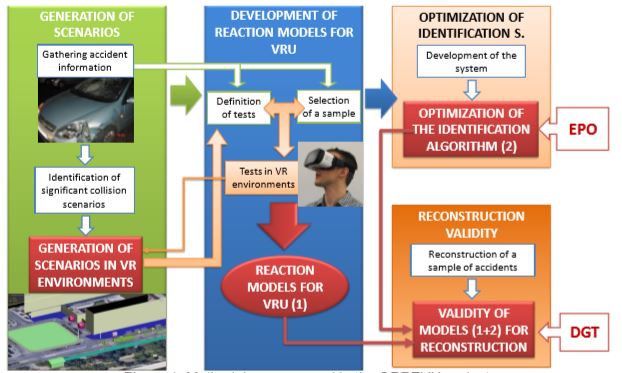
Figure1. Methodology proposed in the OPREVU project
Results
In accordance to the project requisites, a pre-selection of four scenarios has been done by doing an intensive research of the INSIA database of pedestrian accidents in Madrid (between 2002 and 2005). The identification of the scenarios of interest has been approached by means of an in-depth retrospective study of accidents involving vulnerable users in the city of Madrid and a review of the scientific literature on VRU collisions. The following scenarios have been selected:
- Avenida de los Toreros (https://goo.gl/maps/aoX4irPuC2iLA1NS9).
- Avenida de MachuPichu with Manuel Rodrigo (https://goo.gl/maps/QLPnL7JujoaUr34C8).
- C/ Emilio Muñoz 21 (https://goo.gl/maps/c6betkMLyf4RmLWY9).
- C/ Hermanos García Noblejas, 68 (https://goo.gl/maps/V6o56RbBYsXWi36R9).
After the previous selection process, CeDInt-UPM has carried out the generation of the virtual environments. The following methodology has been done by the researchers:
- Selection of the specific itinerary to be followed by subjects immersed in virtual reality.
- Development of the kinematic model of the behavior of pedestrians and cyclists in normal walking, and of vehicles, for synchronism with the virtual reality image.
- Production of the complete virtual scenario software with the static and urban elements, and the initial kinematic models of vehicles, pedestrians and cyclists.
- Hardware selection, analysis of VR glasses and VRU simulators.
- Configuration of VRU simulators for image synchronism.
- Integration of VR software with the synchronism of image and movement of test subjects.
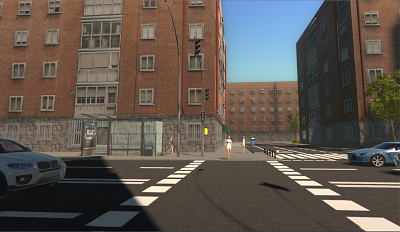
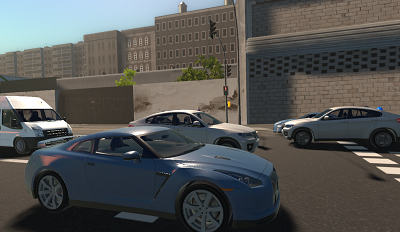
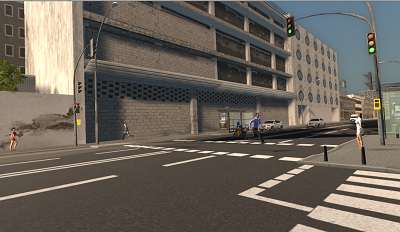
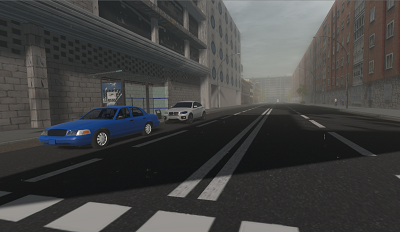
Figure 2. Virtual recreation of one scenario with urban elements (e.g. buildings, streets, street signals) and vehicles and pedestrians.


